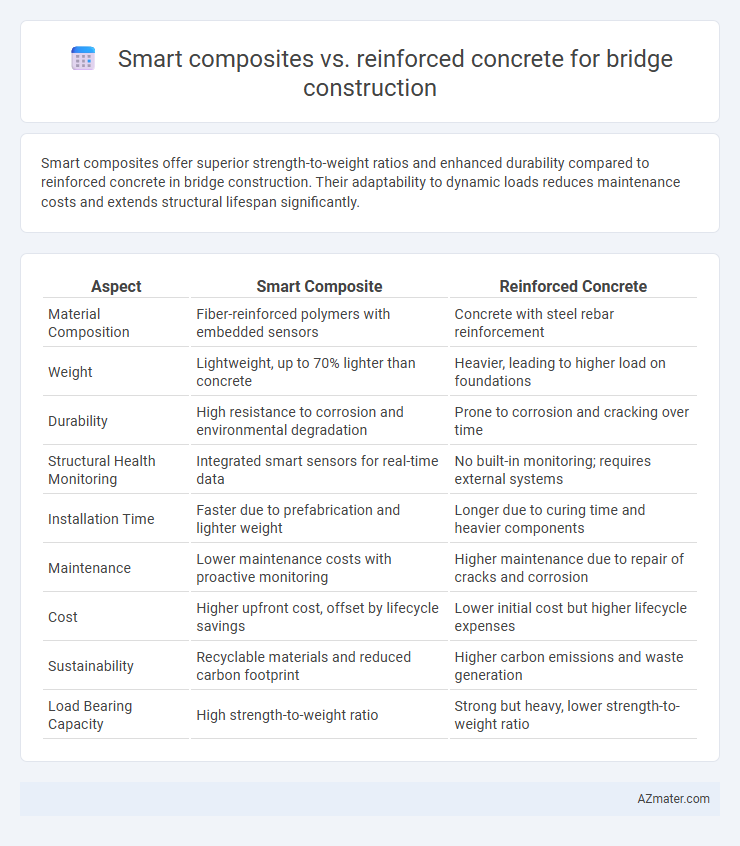Smart composites offer superior strength-to-weight ratios and enhanced durability compared to reinforced concrete in bridge construction. Their adaptability to dynamic loads reduces maintenance costs and extends structural lifespan significantly.
Table of Comparison
| Aspect | Smart Composite | Reinforced Concrete |
|---|---|---|
| Material Composition | Fiber-reinforced polymers with embedded sensors | Concrete with steel rebar reinforcement |
| Weight | Lightweight, up to 70% lighter than concrete | Heavier, leading to higher load on foundations |
| Durability | High resistance to corrosion and environmental degradation | Prone to corrosion and cracking over time |
| Structural Health Monitoring | Integrated smart sensors for real-time data | No built-in monitoring; requires external systems |
| Installation Time | Faster due to prefabrication and lighter weight | Longer due to curing time and heavier components |
| Maintenance | Lower maintenance costs with proactive monitoring | Higher maintenance due to repair of cracks and corrosion |
| Cost | Higher upfront cost, offset by lifecycle savings | Lower initial cost but higher lifecycle expenses |
| Sustainability | Recyclable materials and reduced carbon footprint | Higher carbon emissions and waste generation |
| Load Bearing Capacity | High strength-to-weight ratio | Strong but heavy, lower strength-to-weight ratio |
Introduction to Bridge Construction Materials
Smart composites in bridge construction offer advanced properties such as self-sensing, adaptive deformation, and enhanced durability compared to traditional reinforced concrete. Reinforced concrete, widely used due to its high compressive strength and cost-effectiveness, incorporates steel reinforcement to improve tensile capacity but lacks intelligent responsiveness. The integration of smart composite materials aims to optimize structural health monitoring, reduce maintenance costs, and improve lifespan in modern bridge infrastructure.
Overview of Smart Composites
Smart composites in bridge construction consist of advanced materials integrated with sensors and actuators to enable real-time monitoring and adaptive responses to environmental stresses. These composites offer enhanced durability, reduced maintenance costs, and improved load-bearing capacity compared to traditional reinforced concrete. Their ability to self-diagnose damage and adjust to dynamic loads makes them innovative solutions for extending the lifespan and safety of modern bridges.
Properties of Reinforced Concrete
Reinforced concrete combines concrete's high compressive strength with steel reinforcement's tensile strength, offering durability and resistance to environmental stressors in bridge construction. Its properties include excellent load-bearing capacity, fire resistance, and adaptability to various design requirements, making it a reliable material for structural integrity. Compared to smart composites, reinforced concrete provides proven long-term performance and cost efficiency in large-scale bridge projects.
Structural Performance Comparison
Smart composites in bridge construction exhibit superior tensile strength and corrosion resistance compared to traditional reinforced concrete, enhancing durability and reducing maintenance costs. Reinforced concrete offers high compressive strength and cost-effectiveness but can suffer from chloride-induced corrosion and cracking over time, impacting structural integrity. The integration of smart composites improves structural performance metrics such as load-bearing capacity, fatigue resistance, and lifespan, making them a promising alternative for modern bridge engineering.
Durability and Longevity
Smart composites offer superior durability and longevity in bridge construction due to their resistance to corrosion, chemical attacks, and environmental degradation compared to reinforced concrete. Reinforced concrete structures are prone to cracking, spalling, and reinforcement corrosion, which can significantly shorten service life and increase maintenance costs. The use of smart composites enhances structural health monitoring capabilities, allowing for proactive maintenance and extended bridge lifespan.
Weight and Load-Bearing Capacity
Smart composites offer significantly lower weight compared to reinforced concrete, enhancing ease of transportation and installation in bridge construction. Their high strength-to-weight ratio provides superior load-bearing capacity, allowing for longer spans and reduced structural support. Reinforced concrete, while heavier, delivers robust compressive strength and durability but increases the overall dead load on bridge foundations.
Environmental Impact and Sustainability
Smart composite materials in bridge construction offer significant environmental advantages over traditional reinforced concrete, including reduced carbon emissions due to lower material weight and longer lifecycle durability. Composite materials minimize the need for frequent repairs and replacements, leading to less resource consumption and waste generation over the structure's lifespan. Reinforced concrete, while strong and cost-effective, has a higher embodied carbon footprint from cement production and generates more construction waste, posing greater sustainability challenges.
Cost Analysis and Economic Factors
Smart composite materials for bridge construction offer reduced lifecycle costs due to lower maintenance and longer durability compared to traditional reinforced concrete. While initial investment in smart composites is higher, economic factors such as decreased repair frequency and faster installation drive overall cost efficiency. Reinforced concrete requires substantial upkeep and is prone to corrosion, leading to increased expenses over the bridge's service life.
Case Studies and Real-World Applications
Case studies on bridge construction demonstrate that smart composites offer superior corrosion resistance and reduced maintenance compared to reinforced concrete, enhancing long-term durability in harsh environments. Real-world applications, such as the replacement of bridge decks in coastal areas, showcase smart composites' lightweight properties leading to faster installation and reduced traffic disruptions. Reinforced concrete remains widely used for its cost-effectiveness and high compressive strength, but innovations in smart composite technology are increasingly driving shifts toward hybrid structural solutions in modern infrastructure projects.
Future Trends in Bridge Material Technology
Smart composites in bridge construction offer adaptive properties such as self-sensing and self-healing, improving durability and reducing maintenance costs compared to traditional reinforced concrete. Future trends emphasize integrating nanomaterials and intelligent monitoring systems within smart composites to enhance structural performance and lifespan. Reinforced concrete remains widely used due to its cost-effectiveness and proven strength, but emerging hybrid materials combining smart composites with concrete are expected to revolutionize bridge design and sustainability.

Infographic: Smart composite vs Reinforced concrete for Bridge construction
 azmater.com
azmater.com